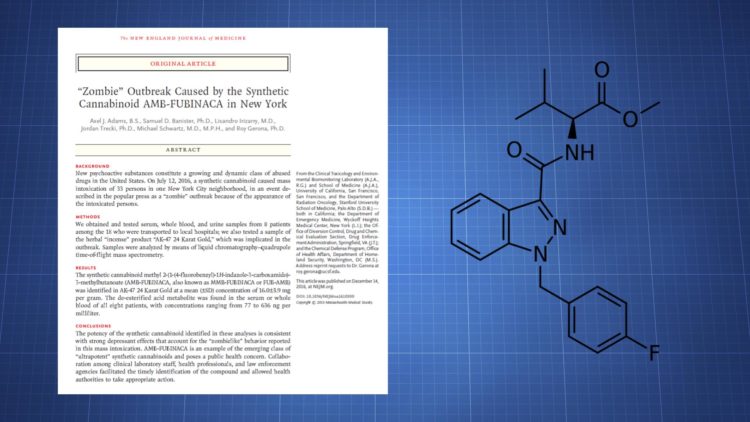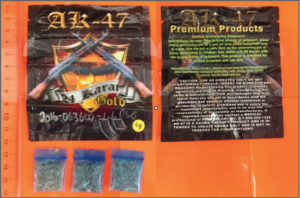Abstract: Dozens of people seemingly overdosed on AMB-FUBINACA, a synthetic cannabinoid, at the same time in July 2016. 18 individuals were taken to local medical centers and no fatalities occurred.
Authors: Axel J. Adams, Samuel D. Banister, Lisandro Irizarry, Jordan Trecki, Michael Schwartz, and Roy Gerona
DOI: 10.1056/NEJMoa1610300
Link: http://www.nejm.org/doi/full/10.1056/NEJMoa1610300
Published: December 14, 2016
Contents
Background
Hundreds of novel psychoactive substances (NPS) have been identified in recent years, with synthetic cannabinoids growing faster than other parts of the NPS market. They really appeared on the market around 2008, initially with substances like JWH-018 and CP 47,497-8.
Some synthetic cannabinoids have been controlled, though new ones continue to appear. They’re often very potent drugs that can easily result in overdose, especially when sold in “herbal blends.”
The substances are typically dissolved in a solvent and applied to an herbal mixture. The product can be smoked like cannabis. When sold in this manner, dosing is inexact, making problematic responses more likely.
AB-FUBINACA entered the market before AMB-FUBINACA. It was described in a 2009 patent from Pfizer and was first reported as a member of the NPS market in Japan in 2012. The drug was being sold in synthetic cannabinoid products. The US scheduled it in January 2014.
AMB-FUBINACA
The drug at the center of this paper, AMB-FUBINACA, is a potent indazole cannabinoid. One pharmacological study indicated it is 85x more potent at CB1 than THC and 50x more potent than JWH-018. It’s structurally similar to AB-FUBINACA.
US authorities first reported the drug’s appearance in 2014 in Louisiana, where it was being sold in a product called “Train Wreck 2.” Louisiana quickly prohibited the substance.
A relatively small number of user reports suggest the drug is indeed a high-potency cannabinoid agonist that can provide cannabis-like effects.
It showed up again in New York City in July 2016.
Case
New York City Emergency Medical Services (EMS) were called to the scene of a “multiple-casualty incident” on July 12, 2016. Dozens of people were under the influence of an unknown drug in the Bedford-Stuyvesant area of Brooklyn.
First responders said the affected individuals shared a similar altered mental status. Bystanders described the users as “zombielike,” a phrase that ended up appearing throughout media reports.
Around 33 people were involved, 18 of whom were transported to two local medical centers. They ranged in age from 25 to 59, with a mean age of 36.8. All were male and eight said they were homeless.
The effects of the drug were reportedly typified by the included case report.
Case report
A 28-year-old male was slow to respond to EMS and he had a “blank stare.” He wasn’t suffering from any clearly life-threatening symptoms, so EMS just monitored his cardiac status and gave him supplemental oxygen on the way to the emergency department (ED).
Once he reached the ED, he was described as lethargic but arousable by tactile stimuli. Sweating was one of the few notable physical effects.
Here were his vitals:
- Heart rate: 88
- Blood pressure: 101/61 mmHg
- Respiratory rate: 21 breaths per minute
- Temperature: 36.7°C (98°F)
- Oxygen saturation: 95%
- Coma score: 13/15
Occasionally he exhibited “zombielike” groaning and he had “slow mechanical” arm and leg movements. All of this fit with a strong CNS depressant effect, possibly from a cannabinoid agonist.
His lethargy and behavior normalized nine hours after admission. He told medical staff that he had inhaled a drug from a packet for the first time. Like every other user taken to a medical center, he didn’t know which drug was in his system.
Response
Once federal (Department of Homeland Security & DEA) and state officials got involved, it was clear the cases were connected to a synthetic cannabinoid product called AK-47 24 Karat Gold.
Analysis of the product revealed the presence of AMB-FUBINACA at concentrations ranging from 12.5 mg to 25.2 mg per gram. That kind of concentration range is one of the major problems with this part of the NPS market.
The DEA obtained biological samples from 8 of the 18 users. While none of the parent compound was detected, every user was positive for a metabolite, 2-(1-(4-fluorobenzyl)-1H-indazole-3-carboxamido)-3-methylbutanoic acid.
That metabolite was present at 0.077 to 0.636 ug/mL in serum.
Summary
Dozens of people seemingly overdosed on AMB-FUBINACA, a potent synthetic cannabinoid receptor agonist, in New York during July 2016. Even though they likely took more than a “common dose,” those who ended up in the hospital didn’t exhibit tachycardia, seizures, hyperthermia, or other more serious responses. This is different from what has been recorded with other synthetic cannabinoids.
The exposures appear to have been tied to a product called AK-47 24 Karat Gold.










